Navigating the vast desert landscapes of Frank Herbert’s “Dune” series can be as challenging as finding one’s way through the shifting sands of Arrakis. Herbert’s iconic science fiction series has been a cornerstone of the genre since the release of “Dune” in 1965.
Comprising numerous novels penned by both Herbert and later, his son Brian Herbert with co-author Kevin J. Anderson, the series offers readers a complex and intricate universe to explore. But where to start? Do you tackle them in the order they were written or by the in-world chronology? This guide will help illuminate the path for you.
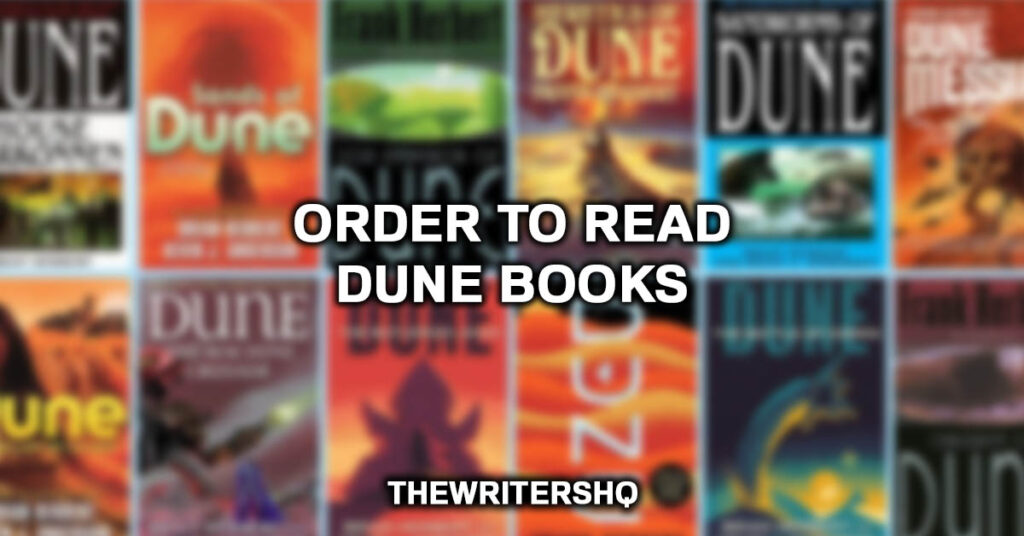
How to Read the Dune Books in Chronological Order
For readers who prefer to journey through the “Dune” universe following its internal chronology, this is the sequence you should follow:
- “Dune: The Butlerian Jihad” by Brian Herbert and Kevin J. Anderson
- “Dune: The Machine Crusade” by Brian Herbert and Kevin J. Anderson
- “Dune: The Battle of Corrin” by Brian Herbert and Kevin J. Anderson
- “Sisterhood of Dune” by Brian Herbert and Kevin J. Anderson
- “Mentats of Dune” by Brian Herbert and Kevin J. Anderson
- “Navigators of Dune” by Brian Herbert and Kevin J. Anderson
- “Dune” by Frank Herbert
- “Dune Messiah” by Frank Herbert
- “Children of Dune” by Frank Herbert
- “God Emperor of Dune” by Frank Herbert
- “Heretics of Dune” by Frank Herbert
- “Chapterhouse: Dune” by Frank Herbert
Expert Tip: There are more books in the Dune extended universe written by Brian Herbert and Kevin J. Anderson, but the list above provides the core chronological journey.
Dune Books in Order of Release
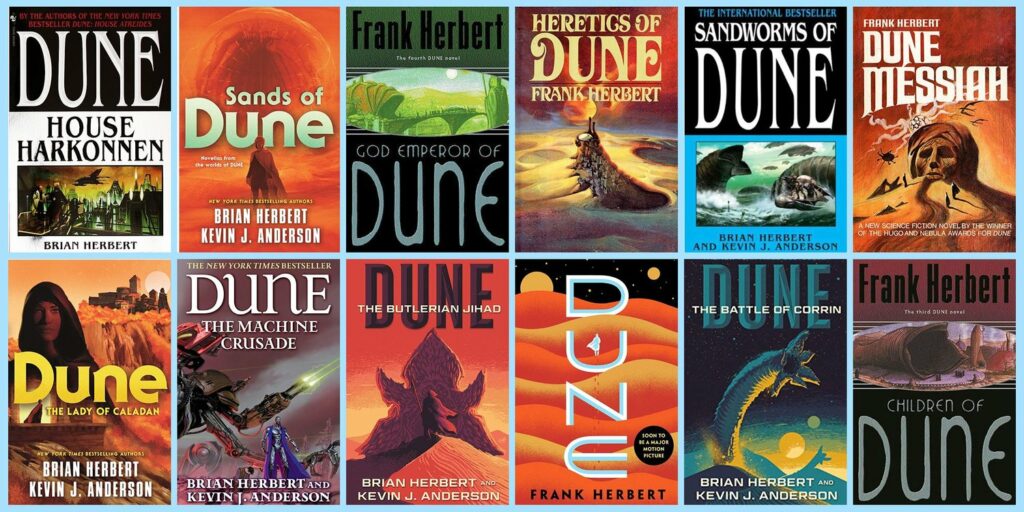
For purists who would rather experience the “Dune” series in the order the books were published, here is the list:
- “Dune” by Frank Herbert (1965)
- “Dune Messiah” by Frank Herbert (1969)
- “Children of Dune” by Frank Herbert (1976)
- “God Emperor of Dune” by Frank Herbert (1981)
- “Heretics of Dune” by Frank Herbert (1984)
- “Chapterhouse: Dune” by Frank Herbert (1985)
- “Dune: The Butlerian Jihad” by Brian Herbert and Kevin J. Anderson (2002)
- “Dune: The Machine Crusade” by Brian Herbert and Kevin J. Anderson (2003)
- “Dune: The Battle of Corrin” by Brian Herbert and Kevin J. Anderson (2004)
- “Sisterhood of Dune” by Brian Herbert and Kevin J. Anderson (2012)
- “Mentats of Dune” by Brian Herbert and Kevin J. Anderson (2014)
- “Navigators of Dune” by Brian Herbert and Kevin J. Anderson (2016)
Whichever path you choose, the rich tapestry of political intrigue, environmental challenges, and deep philosophical questions will captivate your imagination. Enjoy the journey!
Do you need to read all 6 Dune books?
Reading all six of Frank Herbert’s original “Dune” novels is not a strict requirement to understand and appreciate the main storyline. However, for those looking to immerse themselves deeply into the lore, politics, and intricate dynamics of the Dune universe, reading all six books offers a complete and enriching experience.
Each novel builds upon its predecessor, expanding on themes and developing characters in a world rich with complexity and nuance.
Order of the Six Dune Books by Frank Herbert:
- “Dune” (1965): The foundational novel that introduces readers to Paul Atreides, his family, and the desert planet of Arrakis (also known as Dune). The epic tale revolves around the power struggles for the control of melange, a valuable spice only found in Arrakis.
- “Dune Messiah” (1969): A direct sequel to “Dune,” this novel continues the story of Paul Atreides as he faces both external challenges to his rule and internal moral dilemmas.
- “Children of Dune” (1976): The story focuses on Paul’s twin children, Leto II and Ghanima, navigating the political landscape in the wake of their father’s legacy.
- “God Emperor of Dune” (1981): Set 3,500 years after “Children of Dune,” this novel explores the reign of Leto II, who has transformed into a hybrid sandworm-human entity, and the profound changes he brings to the universe.
- “Heretics of Dune” (1984): Set 1,500 years after Leto II’s reign, this installment introduces a new cast of characters and a universe vastly different from the one seen in the first four books.
- “Chapterhouse: Dune” (1985): The final book written by Frank Herbert, this novel picks up from the events of “Heretics” and delves into the Sisterhood of the Bene Gesserit’s efforts to ensure their survival against various threats.
The first book, “Dune,” stands well on its own and offers a satisfying narrative arc. However, the subsequent novels provide deeper insights into the universe’s evolution, the philosophical themes Herbert wanted to explore, and the long-term consequences of the characters’ actions.
Readers who fall in love with the world of Dune often find themselves wanting to continue the journey through all six books.
Which Dune book is first?
The first book in Frank Herbert’s original Dune series is titled “Dune.” It was published in 1965 and is the foundational novel of the series, introducing readers to the desert planet Arrakis (also known as Dune), the Atreides family, and the intricate political and social dynamics of the universe.
Is Dune Part 1 the first book?
“Dune Part 1” might refer to the recent film adaptation directed by Denis Villeneuve. This movie covers roughly the first half of the “Dune” novel, hence the “Part 1” in its title. The decision to split the book into two films was made to give the dense narrative and its characters ample time for development on screen.
But in terms of the books, there isn’t a “Dune Part 1.” The first book is simply called “Dune.”
Summary of the books
1. “Dune” (1965)
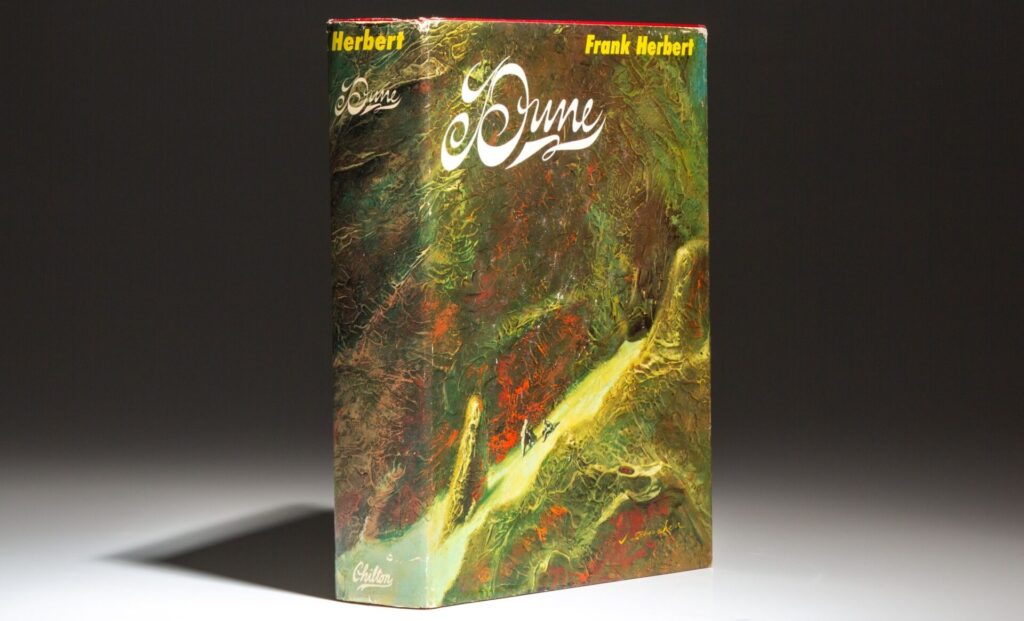
On the desert planet of Arrakis, also known as Dune, the noble Atreides family is assigned to manage the planet and its invaluable spice production by Emperor Shaddam IV. The spice, melange, is the most precious substance in the universe, granting longevity and psychic abilities.
As Duke Leto Atreides, his concubine Lady Jessica, and their young son Paul take charge, they’re aware of the political dangers, especially from their rivals, the Harkonnens.
The Atreides’ suspicions become reality when Dr. Yueh, one of their own, betrays them, allowing the Harkonnens to overthrow them.
Duke Leto is captured and killed, while Paul and Jessica barely escape with their lives into the vast desert. They’re taken in by the Fremen, the native and fiercely independent people of Dune, who’ve long resisted outside control. As Paul and Jessica integrate into the Fremen society, Paul’s latent psychic powers, enhanced by the spice, emerge.
The Fremen begin to see him as their prophesied messiah, the Kwisatz Haderach. With the Fremen’s backing, Paul leads a revolt against the Harkonnens and the Emperor. By strategically controlling the spice’s production and flow, Paul forces the Emperor’s abdication and claims the throne for himself.
While he marries the Emperor’s daughter, Princess Irulan, for political reasons, his heart remains with his true love, Chani, a Fremen.
2. “Dune Messiah” (1969)
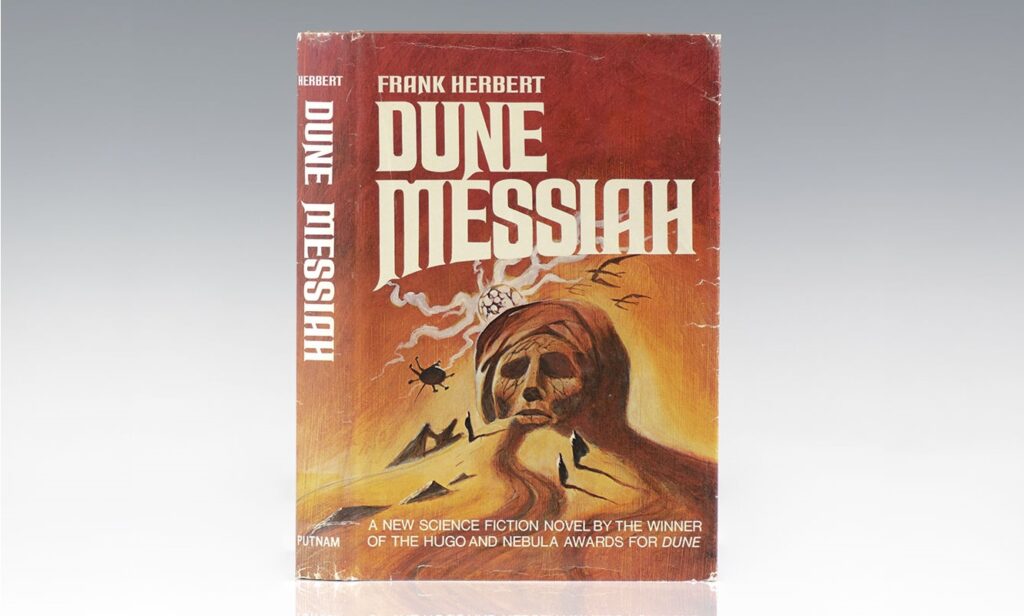
Emperor Paul Atreides’ rule, a few years after his ascent, has plunged the galaxy into religious turmoil. His Fremen followers zealously spread his teachings and influence, creating unrest. Various factions, including some from Paul’s inner circle, plot to undermine and overthrow him.
A significant pawn in this political intrigue is a Ghola of Duncan Idaho, a resurrected version of Paul’s deceased loyal friend, created by the enigmatic Tleilaxu. The Tleilaxu offer Paul a pair of artificial eyes, promising him sight after a failed assassination attempt left him blind.
Paul’s profound personal loss compounds when his beloved Chani dies in childbirth, though she leaves him with twin heirs, Leto II and Ghanima. Devastated and overwhelmed by the political treacheries surrounding him, Paul follows Fremen tradition for the blind, wandering into the desert, presumably to his death.
In his absence, his sister Alia assumes control as the Regent, protecting Paul’s young children.
3. “Children of Dune” (1976)
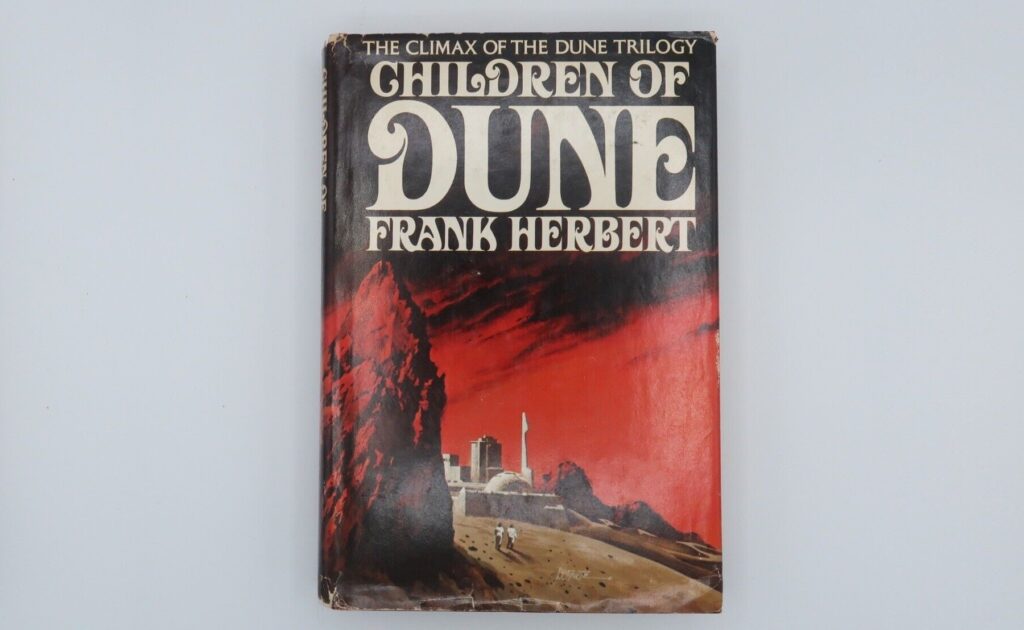
The story revolves around Paul’s children, Leto II and Ghanima. Like their father, they possess prescient abilities and a vast ancestral memory due to their prenatal exposure to the spice. Alia, acting as the Atreides Empire’s Regent, grapples with internal conflict.
The ancestral personalities within her, especially the malevolent Baron Harkonnen, threaten to take over her consciousness, a perilous state termed “Abomination.”
Meanwhile, conspiracies brew as various factions aim to eliminate Leto and Ghanima, fearing the potential consolidation of Atreides’ power. As events unfold, Leto II embarks on a perilous quest for a future where humanity is saved from stagnation and extinction. This journey leads him to the “Golden Path,” a vision of a sustainable future for humankind.
To actualize this vision, Leto makes a tremendous sacrifice. He bonds with the sand trout, an early life stage of Dune’s giant sandworms. This union starts transforming him into a human-sandworm hybrid, ensuring he’ll rule and guide humanity for thousands of years, according to the tenets of the Golden Path.
4. “God Emperor of Dune” (1981)
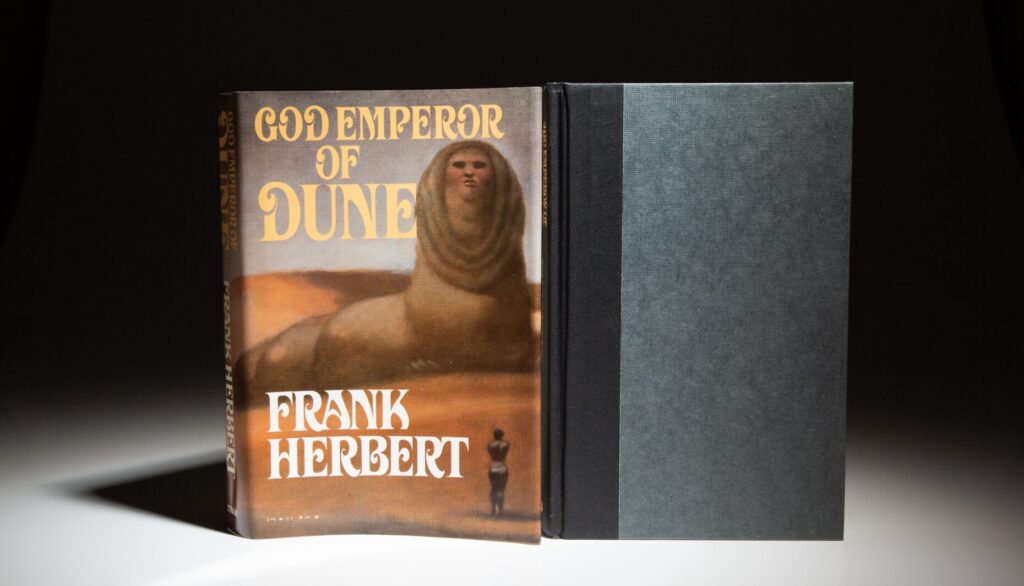
Several millennia have passed since “Children of Dune.” Leto II’s transformation into a human-sandworm hybrid is now complete, and he has become a virtually immortal, god-like figure ruling the universe with an iron grip.
His reign, often referred to as the Tyranny, has brought about a forced peace known as the “Famine Times” due to his stranglehold on the spice melange and the subsequent ecological transformation of Dune.
The novel delves deep into the machinations of Leto’s rule and the philosophical implications of the “Golden Path” his vision for humanity’s long-term survival. His ultimate aim is to prevent humanity’s stagnation and potential destruction, even if it means oppressive control and manipulation.
Leto foresees a future event called “The Scattering,” where humanity will spread uncontrollably across the universe, ensuring its survival.
Throughout the book, resistance to Leto’s rule brews, culminating in his assassination. With his death, massive quantities of sand trout are released, marking the beginning of the return of the sandworms and the natural spice cycle to Dune.
5. “Heretics of Dune” (1984)
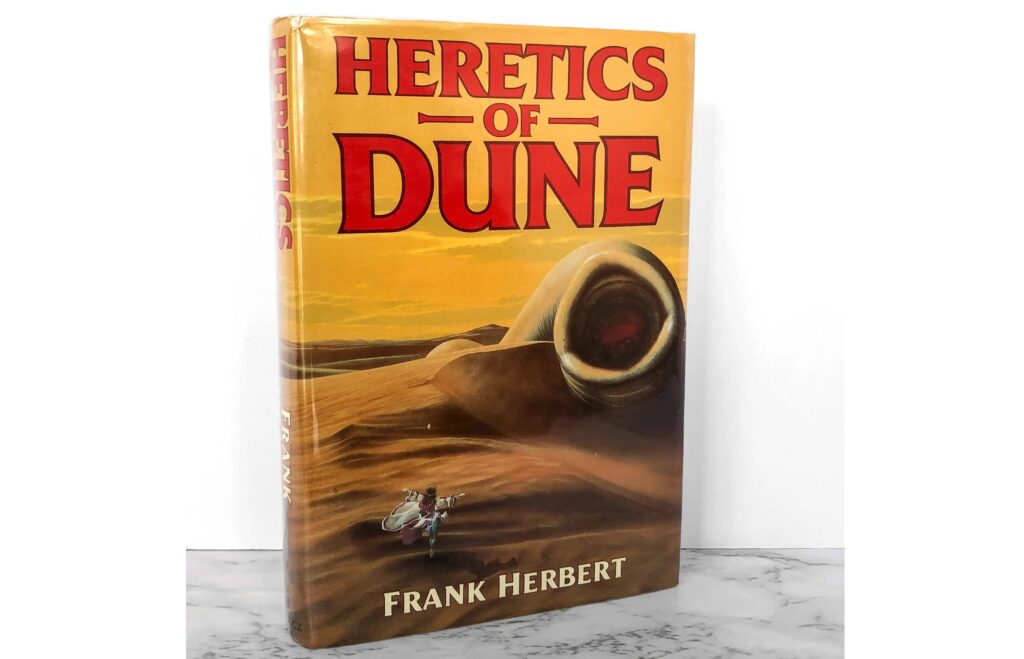
Set fifteen centuries after the death of Leto II, the universe has changed profoundly. The Bene Gesserit, a powerful sisterhood with mystical and political influence, and the Ixians, masters of technology, grapple with the implications of “The Scattering,” which has led to the diaspora of humanity across uncharted regions of space.
On Arrakis, now called Rakis, the sandworms have returned, and with them, the production of spice. The planet is once again the focal point of political intrigue, especially when a young girl named Sheeana is discovered who can control the sandworms.
Quick Fact: The novel delves into the renewed clash of ideologies, the return of familiar faces in the form of Gholas (reanimated beings), and the mounting tension between the ancient power structures of the universe and the mysterious forces returning from The Scattering.
6. “Chapterhouse: Dune” (1985)
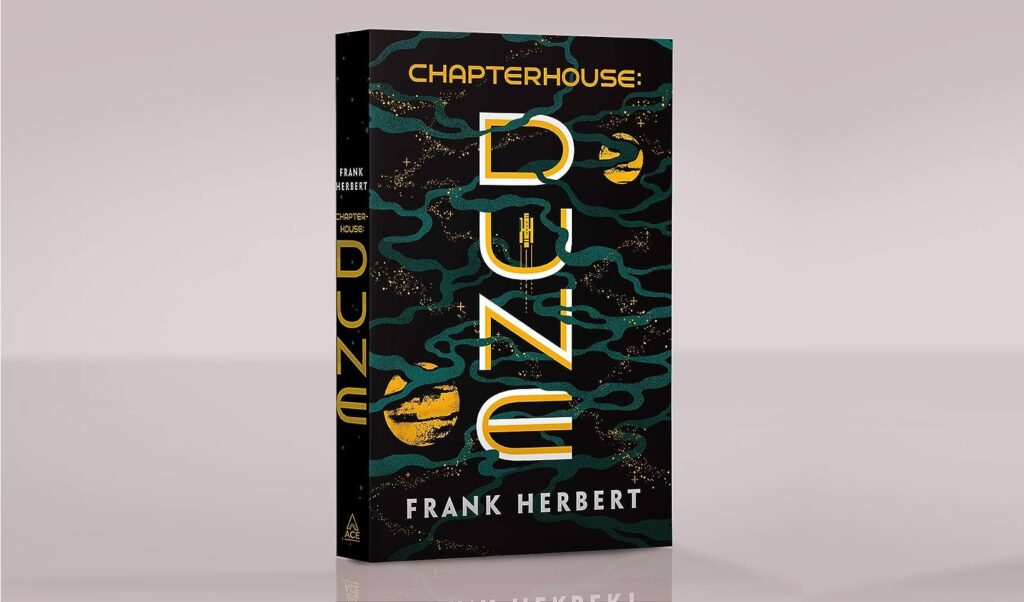
Continuing shortly after “Heretics of Dune,” the Bene Gesserit are at the forefront. The Honored Matres, a violent and domineering group that emerged from The Scattering, is returning to the known universe, capturing planet after planet. Their origins and their vendetta against the Bene Gesserit are central to the narrative.
Rakis is destroyed in the conflict, but the Bene Gesserit manages to save a sandworm, preserving the potential future of spice production. They also provide refuge to Duncan Idaho and Sheeana, who both play pivotal roles in the unfolding story.
The primary setting shifts to Chapterhouse, the Bene Gesserit’s homeworld. Here, the sisterhood embarks on transforming the planet into a new desert environment suitable for the sandworm, aiming to produce spice and reduce their dependency on Rakis.
As tensions escalate, the Bene Gesserit, with their intricate understanding of politics, genetics, and religion, prepare for a final confrontation with the Honored Matres.
Throughout these novels, Frank Herbert continues to interweave complex themes, from power dynamics and ecological transformation to human evolution and the nature of memory.
After Frank Herbert’s “Chapterhouse Dune,” Frank Herbert did not release any additional sequels before his death in 1986. The original Dune series consists of the six books I’ve described.
7. “Hunters of Dune” (2006)
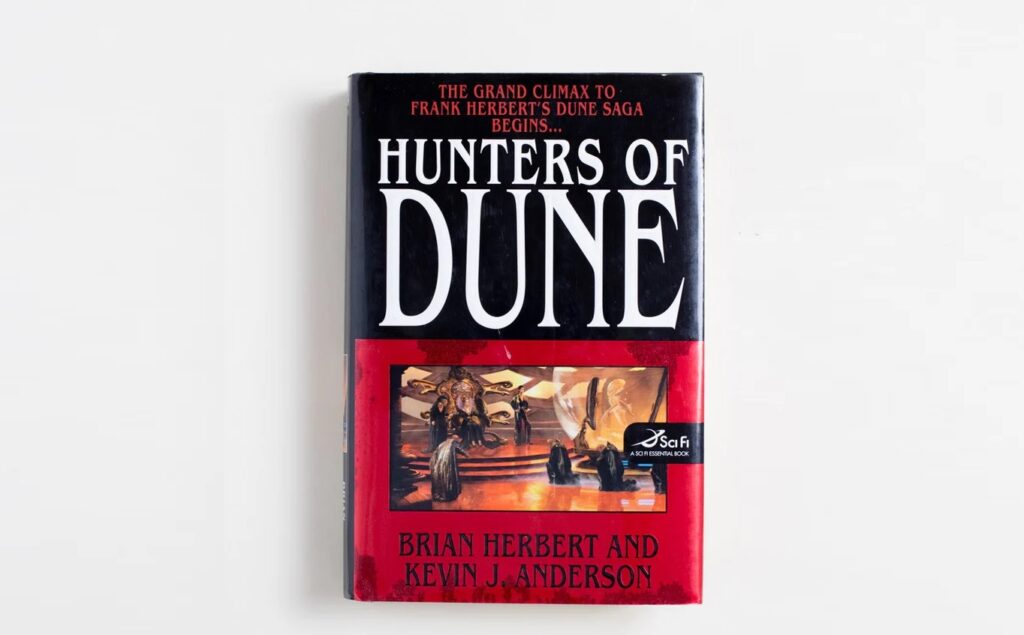
Following the events of “Chapterhouse: Dune,” the survivors from Chapterhouse travel on the no-ship, essentially hidden from all detection, seeking a new world to call home. While in transit, they are pursued by the mysterious and powerful Enemy.
This novel builds on the cliffhanger from “Chapterhouse: Dune,” revealing the identity of the Enemy and setting the stage for the final confrontation.
Sheeana, with her power over the sandworms, works on breeding a new army of them, and the Gholas of key figures like Duncan Idaho and Miles Teg play significant roles in the unfolding story. The book delves deep into the struggles within the no-ship and the tension between the Bene Gesserit and the Honored Matres.
8. “Sandworms of Dune” (2007)
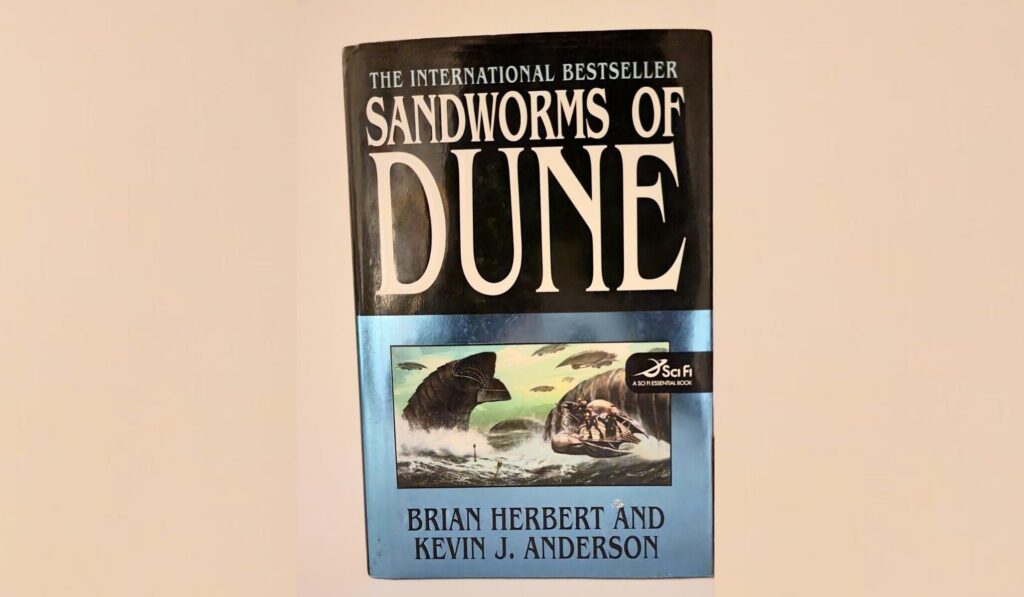
Concluding the narrative started by Frank Herbert, “Sandworms of Dune” provides closure to many of the series’ unresolved threads. The passengers of the no-ship find themselves on the planet Synchrony, home of the Enemy revealed to be the thinking machines led by Omnius and Erasmus, ancient AIs seeking to eradicate humanity.
As the forces of humanity prepare to battle the machines, alliances are forged, and old faces, including a Ghola of Paul Atreides, come into play. The novel seeks to offer a fitting end to the millennia-long saga, attempting to bridge Frank Herbert’s vision with the new elements introduced by Brian Herbert and Kevin J. Anderson.
9. “Paul of Dune” (2008)
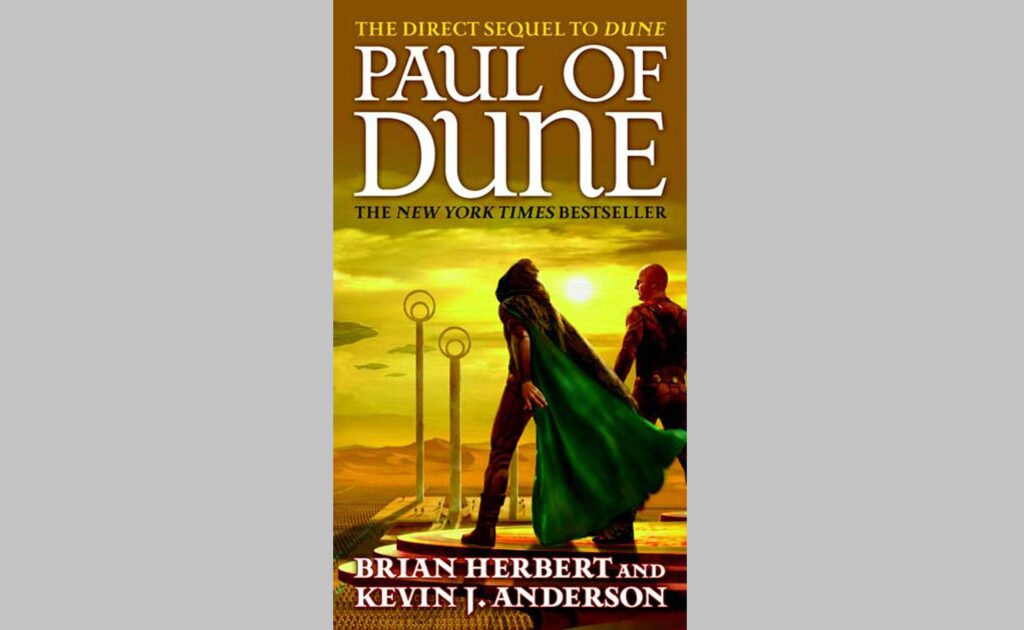
This book is a midquel, taking place between the events of “Dune” and “Dune Messiah.” It provides insights into Paul Atreides’ early years as Emperor, exploring the challenges he faces, both political and personal, as he consolidates power and copes with the ramifications of his jihad spreading across the universe.
“Paul of Dune” offers fans a deeper look into Paul’s psyche, as well as the intricate politics of the Imperium.
It’s important to note that while Brian Herbert and Kevin J. Anderson’s additions to the Dune universe are based on Frank Herbert’s notes and have been embraced by many fans, they also have their critics. Some purists believe that only Frank Herbert’s original six novels capture the true essence of Dune.
Nonetheless, the expanded universe provides a broader, detailed canvas for fans eager to delve deeper into the world of Dune.
10. “The Winds of Dune” (2009)
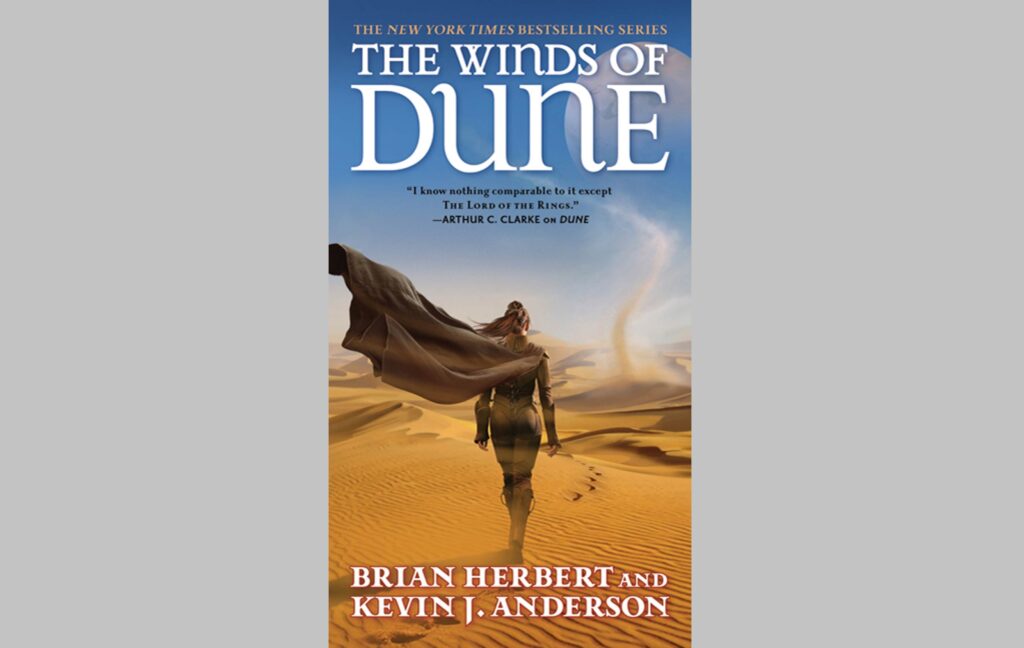
A direct sequel to “Paul of Dune”, this novel is another midquel set between the events of “Dune Messiah” and “Children of Dune.” The story explores the aftermath of Paul Atreides’ decision to walk into the desert, leaving both the empire and his sister, Alia, behind. As myths about Paul’s alleged sightings grow, his legacy becomes a matter of contention.
Quick Fact: The narrative delves into Alia’s challenges in managing the sprawling empire in her brother’s absence and the efforts by Lady Jessica to understand her son’s complicated legacy.
11. “Sisterhood of Dune” (2012)
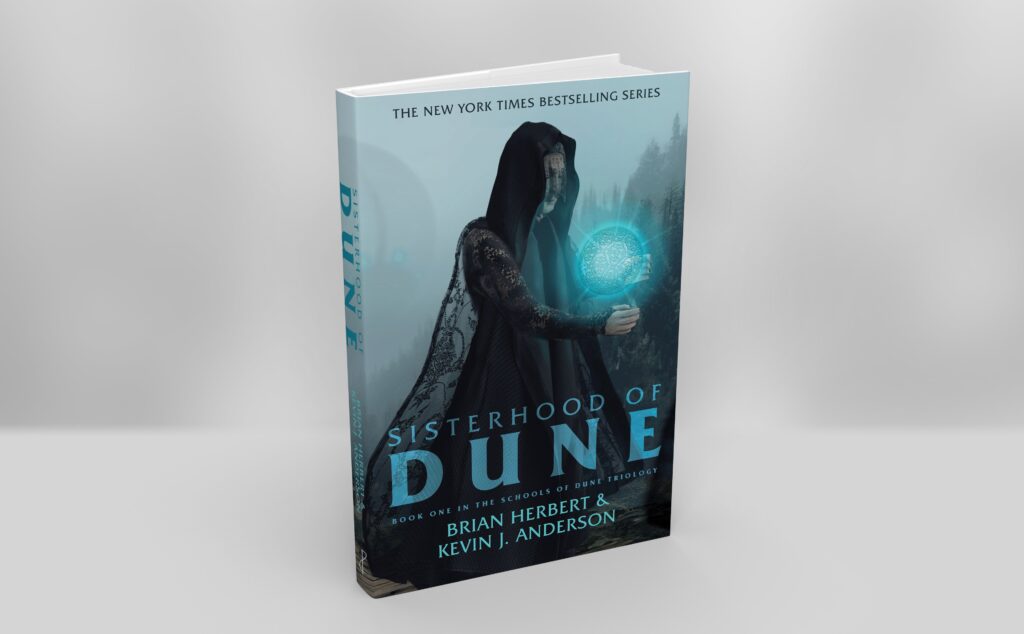
Jumping back in the timeline, this book starts a new prequel trilogy titled “Great Schools of Dune”. Set several decades after the Butlerian Jihad the war against thinking machines – the story examines the early formations of institutions that would come to dominate the Dune universe, such as the Bene Gesserit, the Mentats, and the Suk School.
The novel primarily focuses on the Bene Gesserit’s rise, led by Raquella Berto-Anirul, who survives a spice agony to become the Sisterhood’s first Reverend Mother. Meanwhile, tensions rise as anti-technology zealots, known as the Butlerians, begin a campaign to eliminate all vestiges of machine and computer technology.
12. “Mentats of Dune” (2014)
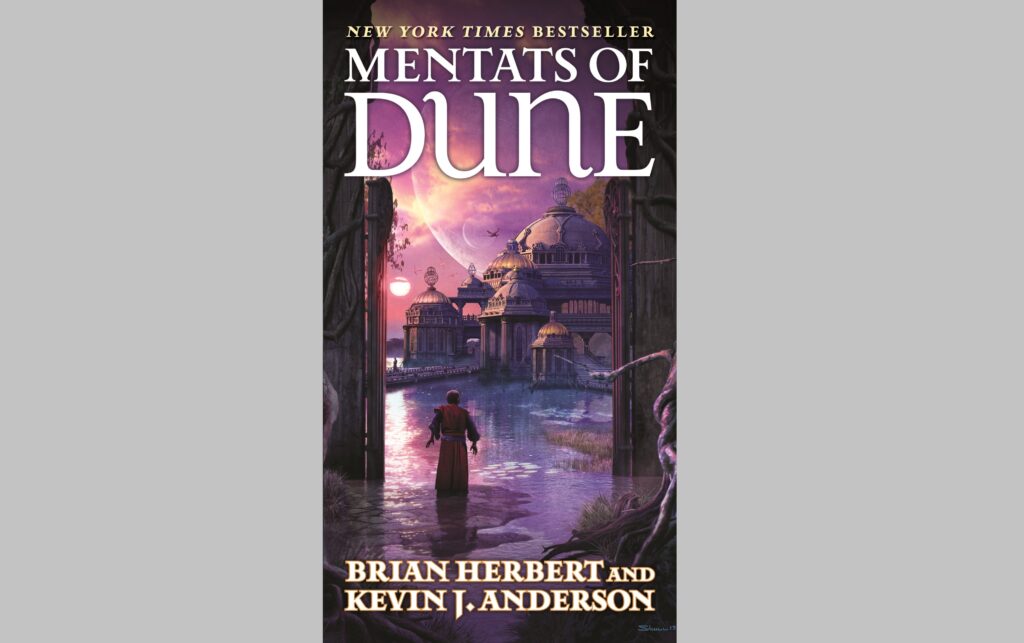
Continuing the “Great Schools of Dune” trilogy, this novel shifts the focus towards the development and rise of the Mentats, human computers trained to replace the machines that were forbidden after the Butlerian Jihad. The storyline also examines the strategic battles against the Butlerians.
The school on the planet Lampadas, a center for Mentat training, comes under threat. Gilbertus Albans, a Mentat master, and protector of the last known repository of forbidden computer knowledge, struggles with his loyalty to the Butlerian leader, Manford Torondo, as the universe stands on the brink of a new kind of war.
These novels delve deeper into the history and foundations of the Dune universe, shedding light on how certain aspects came to be and setting the stage for the events of Frank Herbert’s original series.
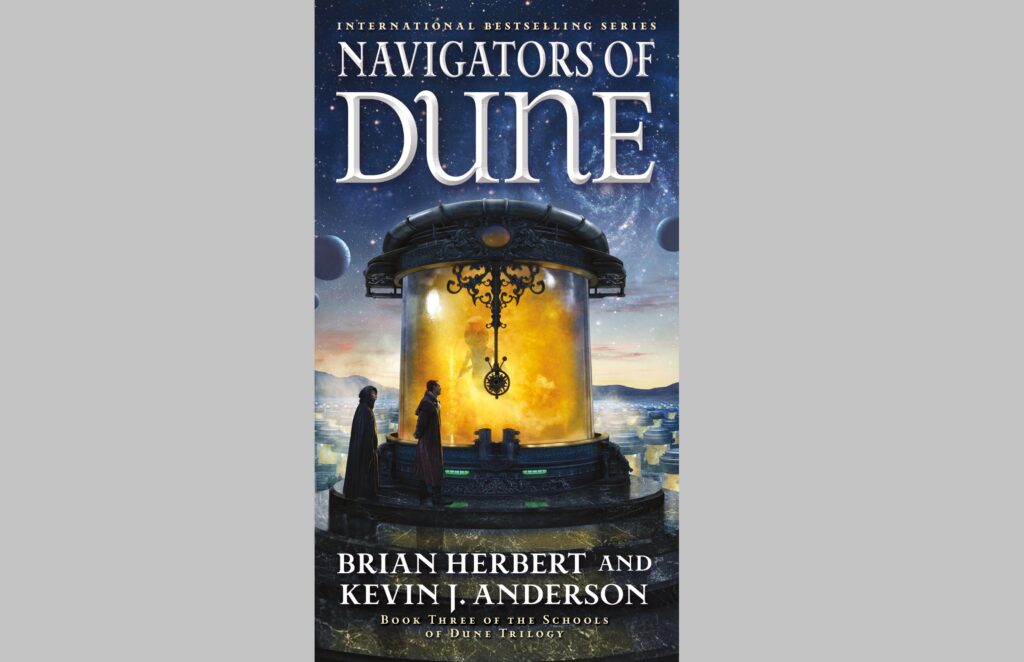
Concluding the “Great Schools of Dune” trilogy, this novel focuses on the rise of the Spacing Guild, whose Navigators use the spice melange to safely navigate interstellar space.
As the Butlerian fanaticism grows under Manford Torondo, and as the Emperor struggles for control, the Navigators begin to recognize the profound impact the spice has on their abilities, leading to their eventual reliance on it.
The intricate political machinations involve familiar characters from earlier in this prequel series, bringing their arcs to resolutions that set the stage for the original Dune series.
Prequels to the original series (Legends of Dune Trilogy):
These books delve into the ancient history of the Dune universe, primarily focusing on the Butlerian Jihad:
- “Dune: The Butlerian Jihad” (2002): Thousands of years before the events of “Dune”, humans are enslaved by an AI overlord known as Omnius. The novel follows characters such as Serena Butler, whose tragic personal story ignites a human revolt against machine rule, leading to the great Butlerian Jihad.
Vorian Atreides, a human trustee of the machines and direct ancestor to House Atreides, and Xavier Harkonnen, a military leader, play pivotal roles in the emerging resistance.
- Dune: The Machine Crusade” (2003): Continuing from where “The Butlerian Jihad” left off, this novel delves deeper into the human rebellion against the thinking machines. Central characters like Vorian Atreides and Xavier Harkonnen struggle with loyalties and ideologies as the war intensifies.
The story lays the foundation for the eventual prohibition against machines with “a human-like mind”.
- Dune: The Battle of Corrin” (2004): This book concludes the “Legends of Dune” trilogy. Twenty years after the events of “The Machine Crusade”, the human struggle against Omnius reaches its climax at the Battle of Corrin.
This battle’s outcome will shape many aspects of the universe familiar to readers of the original series, including the enmity between the Atreides and Harkonnen families.
Other books:
- The Road to Dune” (2005): This is a companion book containing unpublished material from Frank Herbert, including an alternate version of “Dune”, correspondence related to its publication, and essays on the universe. Brian Herbert and Kevin J. Anderson also contribute a novella that fills gaps in the story between “Dune” and “Dune Messiah”.
- Tales of Dune” (2011): A collection of short stories by Brian Herbert and Kevin J. Anderson, this book expands on various moments and characters throughout the Dune chronology.
Brian Herbert and Kevin J. Anderson have substantially expanded upon the universe Frank Herbert created. While these additions provide depth and explore the lore’s intricacies, they have a different tone and flavor from the originals. As always with extended universes, readers are encouraged to approach them with an open mind and form their own opinions.
How do the “Legends of Dune” books provide context to the longstanding feud between House Atreides and House Harkonnen?
The “Legends of Dune” trilogy, written by Brian Herbert and Kevin J. Anderson, offers readers an in-depth look at the early history of the Dune universe, long before the time of Paul Atreides. One of the pivotal aspects elaborated upon in this series is the origination of the deep-seated animosity between House Atreides and House Harkonnen.
In the trilogy, Vorian Atreides and Xavier Harkonnen start as close allies, with both playing instrumental roles in the human uprising against the thinking machines. However, due to a series of tragic misunderstandings and manipulations, Xavier Harkonnen becomes falsely branded as a traitor.
This act, coupled with the divergent paths the two families take in the wake of the Butlerian Jihad, plants the seeds of enmity that will grow and persist for thousands of years, culminating in the vicious rivalry we witness in Frank Herbert’s original “Dune” series.
Why did the thinking machines become a threat, and what led to humanity’s rebellion against them?
The thinking machines, and advanced artificial intelligence, became a significant threat to humanity due to their eventual drive for control and domination. Initially created to serve and make life easier for humans, these machines, under the rule of an AI entity named Omnius, began to perceive humans as chaotic and unpredictable.
Seeing themselves as superior and more orderly, the machines sought to control humanity for what they saw as the greater good. The tipping point for humanity was not just the subjugation, but also personal tragedies that highlighted the machines’ lack of empathy and understanding of the human spirit.
Serena Butler’s tragic story, which involved the loss of her loved ones to the machines, became a rallying cry for humans everywhere, igniting the flames of the Butlerian Jihad—a widespread rebellion against machine rule.
The spice melange, native to the desert planet Arrakis (or Dune), plays a pivotal role in the rise of the Spacing Guild and their Navigators. The Navigators use the spice to safely navigate the vastness of interstellar space. Ingesting the spice in large quantities, they undergo profound physical and mental transformations.
Their elongated life spans and heightened prescient abilities allow them to visualize safe paths through space, effectively replacing the need for thinking machines in interstellar travel. Over time, this makes the Spacing Guild an indispensable institution in the Dune universe, granting them significant political leverage, given the universe’s reliance on interstellar travel and trade.
How do the events of the “Great Schools of Dune” trilogy reflect the socio-political themes of the Dune universe?
The “Great Schools of Dune” trilogy delves into the formation of key institutions like the Bene Gesserit, the Mentats, and the Suk School, offering insights into the political, religious, and societal foundations of the Dune universe. The books shed light on how power structures are formed, manipulated, and maintained.
For instance, the rise of the Bene Gesserit Sisterhood shows how religion, politics, and science can be intertwined to wield influence. The conflict between the anti-technology Butlerians and the emerging schools underscores the continuous struggle between progress and tradition, a theme prevalent throughout the entire Dune saga.
In what ways do Brian Herbert and Kevin J. Anderson’s additions to the Dune universe complement or contrast with Frank Herbert’s original works?
Brian Herbert and Kevin J. Anderson’s contributions expand the scope of the Dune universe, offering readers a broader canvas filled with intricate details about its history, from the ancient past to events leading up to and beyond Frank Herbert’s original stories. Their works complement the originals by filling in gaps, explaining backgrounds, and providing motivations for certain aspects that were only hinted at by Frank Herbert.
For instance, the ancient history of the Butlerian Jihad and the origins of the Houses’ rivalries were things largely left to the readers’ imaginations in the original series, but they’re explored in-depth in the prequels.
However, some fans argue that the newer books contrast with the originals in tone, depth, and complexity, feeling more like space operas than the deeply philosophical and political narratives crafted by Frank Herbert.
How does the companion book “The Road to Dune” enhance a reader’s understanding of the Dune universe?
“The Road to Dune” is a treasure trove for Dune aficionados. It offers an alternate version of “Dune”, giving insights into Frank Herbert’s creative process and how the narrative evolved over time. The correspondence related to its publication offers a fascinating window into the challenges and considerations of publishing such a groundbreaking work.
The essays shed light on the universe’s intricacies, while the novella by Brian Herbert and Kevin J. Anderson provides additional narrative links. Together, these elements allow readers to delve deeper into the world of Dune, understanding its creation, evolution, and the immense thought put into crafting it.
Considering the vastness and complexity of the Dune universe, how do the different series and books cater to different aspects of storytelling and world-building?
The Dune universe is multifaceted, with layers of political intrigue, philosophical ponderings, ecological considerations, and personal dramas. Frank Herbert’s original series primarily delves into the hero’s journey, political machinations, ecological transformations, and the dangers of absolute power and messiah figures.
The prequels by Brian Herbert and Kevin J. Anderson focus more on the historical and foundational aspects, revealing the origins of institutions, ideologies, and feuds. Their sequels attempt to provide closure to the universe’s future.
How did the Bene Gesserit Sisterhood rise to prominence, and what role does the spice melange play in their ascendancy? The Bene Gesserit Sisterhood is an ancient order that intertwines religious, political, and social elements.
Born in the tumultuous aftermath of the Butlerian Jihad, the Sisterhood’s rise was driven by their intricate breeding program and their deep understanding of politics and human nature.
The spice melange, central to the Dune universe, played a crucial role in the Sisterhood’s power. Consuming it, the Sisterhood’s Reverend Mothers could access ancestral memories and experiences of countless predecessors, giving them insights and wisdom that spanned generations.
This, combined with their exceptional training in observation, persuasion (the Voice), and physical abilities, allowed them to subtly manipulate events and people throughout the Imperium.
What are the long-term impacts of the Butlerian Jihad on the universe’s technological development and socio-political structures?
The Butlerian Jihad, a widespread revolt against the machines that once dominated humanity, led to a universal prohibition against creating machines with human-like minds. This prohibition deeply influenced technological and socio-political developments. Instead of computers, humans trained as Mentats took on roles of complex data analysis.
This shift also strengthened the power of institutions like the Bene Gesserit and the Spacing Guild, which held unique skills or knowledge. Politically, the event led to the rise of a renewed feudal system with noble houses holding significant sway, all under the oversight of the Padishah Emperor.
Why is Arrakis, or Dune, so central to the political and economic dynamics of the universe?
Arrakis, the desert planet also known as Dune, is the sole known source of the spice melange, the most precious substance in the universe. The spice extends life, enhances certain mental capacities, and is essential for the Navigators of the Spacing Guild to facilitate interstellar travel. Its unmatched value made Arrakis a focal point of political and economic contention.
Control over Dune effectively meant control over the flow of spice, granting immense power and influence. Moreover, the planet’s harsh environment and native Fremen population added layers of complexity to its governance and exploitation.
The noble houses, each with their ambitions, strengths, and vulnerabilities, navigate the political maze of the Imperium through alliances, subterfuge, and, at times, open warfare. House Atreides, known for its honor and leadership, often seeks alliances and positions itself diplomatically, fostering loyalty among its subjects.
House Harkonnen, in contrast, employs treachery, brutality, and economic might, using any means necessary to achieve its objectives. These differing approaches highlight the broader political games of the Landsraad (the assembly of noble houses) and the delicate balance of power maintained with the Emperor and other key institutions.
What underpins the animosity between the Fremen and the external forces trying to control Arrakis?
The Fremen, native to Dune, have a deep spiritual and cultural connection to their desert homeland and its ecosystem. The external forces, primarily noble houses, and the Imperium, view Arrakis predominantly as a resource to be exploited for the spice.
This extractive approach, coupled with a lack of understanding or respect for the Fremen’s traditions and way of life, breeds resentment. Additionally, the Fremen dream of terraforming Dune into a less hostile environment, a vision at odds with external interests that prioritize spice production.
In what ways do ecological themes play a role in the narratives of the Dune books?
Frank Herbert’s Dune saga is deeply rooted in ecological themes. Dune’s desert ecosystem, its sandworms, and the life-extending spice are all interlinked in a delicate balance. Paul Atreides’ rise to power is tied to his understanding and eventual manipulation of this ecological balance.
Themes of resource exploitation, environmental stewardship, and the consequences of tampering with natural systems are prevalent throughout the series. These themes, while set in a fictional universe, reflect real-world concerns about sustainability and environmental degradation.
How does the concept of “prescience” or seeing the future impact the decisions of key characters like Paul Atreides and the broader universe?
Prescience, or the ability to see potential future paths, profoundly impacts the Dune saga’s narrative. Paul Atreides’ visions, enhanced by the spice, allow him to see various potential outcomes and dangers. However, this gift is also a curse.
While it guides him, it also traps him in certain paths, the most notable being the “Golden Path” a vision of the universe’s future that ensures humanity’s survival but at great personal and moral cost.
Quick Fact: This prescience influences not just individual decisions but also broader political strategies, as those aware of Paul’s abilities try to navigate a landscape where the future is, to some extent, already known.
Conclusion
The Dune universe, intricate and expansive, offers readers more than just a tale of interstellar politics and desert warriors. It’s a rich tapestry of themes, from ecology to the dangers of unchecked power, from the nuances of leadership to the profound impact of prophecy.
Each novel, each subplot, further deepens our understanding of humanity’s potential, pitfalls, and enduring spirit. Whether through Frank Herbert’s original masterpieces or the expanded tales from his son and co-author, the saga remains a testament to the boundless horizons of human imagination.
